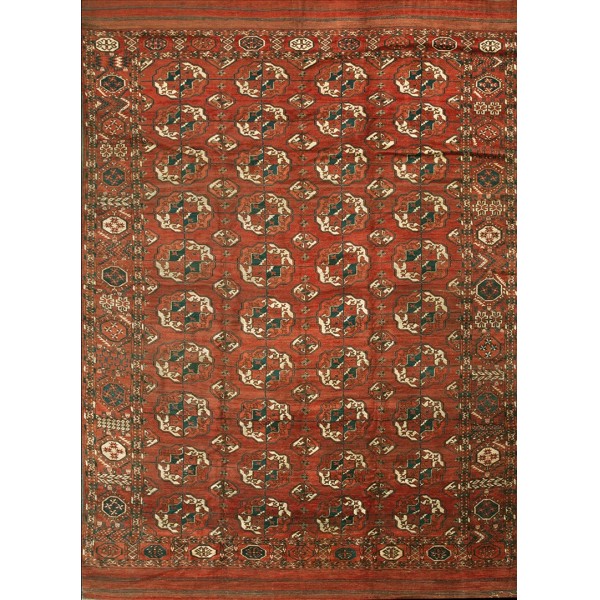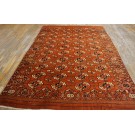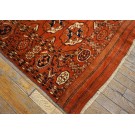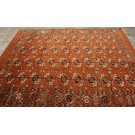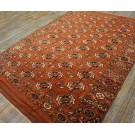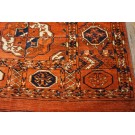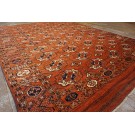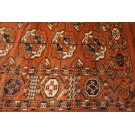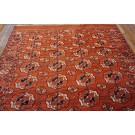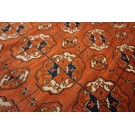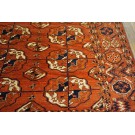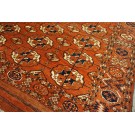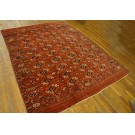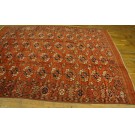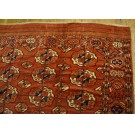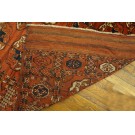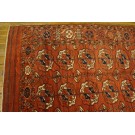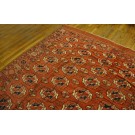Mid 19th Century Central Asian Tekke Turkmen Main Carpet
Tekke Turkmen Main Carpet
Turkmenistan Central Asia
6.6 x 9.0
Third quarter 19th century
Warp: wool, natural, beige, Z-2-S
Weft: wool, two shoots alternating light brown, natural, Z-2-S
Pile: wool, 2 strands, Z spun
Knot: asymmetric open right, approx.120 knots/square inch; no alternate warp depression
Sides: one body warp bundle wrapped I n sapphire blue wool
Ends: fringed out, not original
This is a fine example of the tet/yurt sized Teke main carpet with a four by ten layout of emblematic tribal guls, with interstitial minors in octagon form, often seen on Salor bags and carpets, instead of the more usual chemche or kurbaghe minors. The red field is from madder, and the blue lines connecting the guls and filling in details is from indigo, dyed not on the steppe as the others were, but by professional specialized artisans in a local town. The wool is from the family’s own flocks gathered in the spring clip. Spring clip wool is softer, more elastic and resilient and takes dye better than the drier, less desirable autumn clip. This carpet is transitional in that it still retains the traditional format, but employs some later innovations. First, there octagons in the main border use both the quadruple star motif and the cross device. The quadruple stars is an older motif and appears uniformly on earlier pieces, whereas the cross centered octagon is a later motif and takes over completely after about 1880. Another point of transition are the pile, striped elems which copy the flatwoven end elems of earlier pieces which are in red with three triples of dark blue stripes. The pile elems are a later feature which will soon be filled with a rayed lozenge design. The gul numbering is consistent with the date as the earliest Tekke main carpets show a 4 x 8 or 4 x 9 configuration. The guls have gotten slightly smaller, but are still roundish and well-spaced. Also the size is consistent with tent manufacture for domestic or local use, the larger size being more directed toward export. The use of the minor gul is exceptional and nearly all Tekke main carpets of the period employ other minors as noted above. There are no repairs, but one elem corner needs proper work to tidy it up. The rug was made in one summer, by a woman and her daughter. There are no lazy lines and the wefts run straight across.
Turkmenistan Central Asia
6.6 x 9.0
Third quarter 19th century
Warp: wool, natural, beige, Z-2-S
Weft: wool, two shoots alternating light brown, natural, Z-2-S
Pile: wool, 2 strands, Z spun
Knot: asymmetric open right, approx.120 knots/square inch; no alternate warp depression
Sides: one body warp bundle wrapped I n sapphire blue wool
Ends: fringed out, not original
This is a fine example of the tet/yurt sized Teke main carpet with a four by ten layout of emblematic tribal guls, with interstitial minors in octagon form, often seen on Salor bags and carpets, instead of the more usual chemche or kurbaghe minors. The red field is from madder, and the blue lines connecting the guls and filling in details is from indigo, dyed not on the steppe as the others were, but by professional specialized artisans in a local town. The wool is from the family’s own flocks gathered in the spring clip. Spring clip wool is softer, more elastic and resilient and takes dye better than the drier, less desirable autumn clip. This carpet is transitional in that it still retains the traditional format, but employs some later innovations. First, there octagons in the main border use both the quadruple star motif and the cross device. The quadruple stars is an older motif and appears uniformly on earlier pieces, whereas the cross centered octagon is a later motif and takes over completely after about 1880. Another point of transition are the pile, striped elems which copy the flatwoven end elems of earlier pieces which are in red with three triples of dark blue stripes. The pile elems are a later feature which will soon be filled with a rayed lozenge design. The gul numbering is consistent with the date as the earliest Tekke main carpets show a 4 x 8 or 4 x 9 configuration. The guls have gotten slightly smaller, but are still roundish and well-spaced. Also the size is consistent with tent manufacture for domestic or local use, the larger size being more directed toward export. The use of the minor gul is exceptional and nearly all Tekke main carpets of the period employ other minors as noted above. There are no repairs, but one elem corner needs proper work to tidy it up. The rug was made in one summer, by a woman and her daughter. There are no lazy lines and the wefts run straight across.
| Stock ID: | #21179 |
| General Rug Type: | Baluch-Turkmen |
| Specific Rug Type: | Turkmen - Tekke |
| Circa: | 1850 |
| Ground Color: | Soft Rust |
| Border Color: | Soft Rust |
| Origin: | Russia |
| Material: | Wool |
| Weave: | Pile - Knotted |
| Shape: | Rectangle |
| Width: | 6' 6" ( 198 cm ) |
| Length: | 9' ( 274 cm ) |
| Tearsheet Download |
